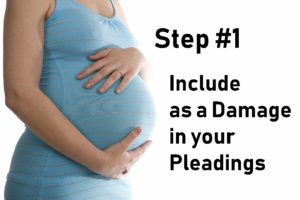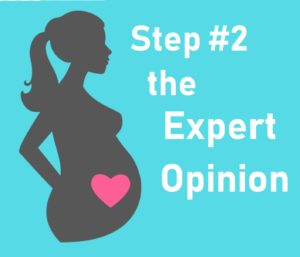
HOW TO WIN COMPENSATION WHEN AN ACCIDENT REDUCES YOUR ABILITY TO GET PREGNANT
The least visible injuries too often cause the greatest harm. This is an unfortunate fact. For example, an accident reducing the happy prospect of a future child is worse than a broken arm, or a cut leg. Unfortunately, our legal and medical systems do a poor job of dealing with these serious injuries; injuries that reduce fertility. This article teaches a manner of overcoming and winning compensation for the diminished ability to get pregnant.
Injury accidents cause severe changes in lifestyle and physical ability.
- Accident injuries can cause a lengthy time period where the body undergoes great stress.
- Disability reduces the ability to exercise.
- Treatment can alter diet.
- Medications alter your physiological condition.
Injury can Harm Fertility: Any number of these factors can reduce the ability of a female victim to become pregnant. Weight gain can alter menstrual cycles. Pharmaceutical drugs can negatively affect fertility. Many injuries have the side effect of diminishing ovulation and other reproductive cycles. Doctors, lawyers, and insurance adjusters often don’t think of this harm. However, for a family, planning a child, this can be the single most important aspect going on in their lives.
No one would want to take a child away from someone and replace it with disability, pain, and medical treatment. Unfortunately, this is too often the case. To make matters worse, compensation is difficult to win through lawsuits if the courts do not allow physician testimony of the reduced ability to become pregnant.
There is a way to overcome the legal barriers.

First, a great accident lawyer will educate the court that the reduced ability to become pregnant is present in the “pleadings.” This means that in his original petition for damages or complaint, the injury accident lawyer actually writes as an item of damages the reduced pregnancy disability. This will allow an initial relevance finding by the court.
For example, the following courts have made similar rulings.
- Boehm v. St. Louis Public Service Co., 368 S.W.2d 361 (Mo. 1963);
- Condos v. Associated Transport, Inc., 453 S.W.2d 682 (Mo. App.E.D 1970);
- Marshall v. Brown, 608 S.W.2d 105 (Mo. App. E.D. 1980).
There are many Continuing Legal Education programs that teach how to create continuity of your pleadings from the beginning of the case until trial. It is easy for the accident injury lawyer to get lulled into complacency and fail to do this. True, each case is unique and has novel evidence. However, most cases overlap with their concepts of fault, injury, and evidentiary concerns. Most cases do not require lawyers to build the habit of a consistent case theme. However, this should ALWAYS be on the list of things to do.
Remaining consistent in pleadings is especially important when the accident lawyer anticipates bringing an unusual claim, like fertility loss (reduced chance of pregnancy) as an item of damages. This should be an ongoing theme among the pleadings, so your judge may more easily remember the case and be motivated to learn its merits. A Trial Brief is not enough. Start with your Petition for Damages, then include the concepts in injury interrogatories, requests for the production of documents, requests for admissions, motions in limine, and so on. Ask questions about the fertility-loss theme in depositions, even when the witness does not directly have information on fertility-loss. Remember, your case is about what your case spends time being about!
 Second, the lawyer needs to gain an expert opinion from a treating physician (or recognized medical expert) as to the reduction of pregnancy possibility. The relatively unknown, but instructive case of McKersie v. Barnes Hospital, 912 S.W. 2d 562 (Mo. App. 1995) is educational on this topic. In McKersie, the Missouri Court of Appeals considered a victim who had an accident. The accident reduced the victim’s ability to get pregnant. Ms. McKersie was treated in an emergency room by an intern. That intern was negligent and failed to diagnosis her appendicitis. As a result, Ms. McKersie’s appendix ruptured. This required her right ovary and her Fallopian tube to be removed. Her appendix was also removed.
Second, the lawyer needs to gain an expert opinion from a treating physician (or recognized medical expert) as to the reduction of pregnancy possibility. The relatively unknown, but instructive case of McKersie v. Barnes Hospital, 912 S.W. 2d 562 (Mo. App. 1995) is educational on this topic. In McKersie, the Missouri Court of Appeals considered a victim who had an accident. The accident reduced the victim’s ability to get pregnant. Ms. McKersie was treated in an emergency room by an intern. That intern was negligent and failed to diagnosis her appendicitis. As a result, Ms. McKersie’s appendix ruptured. This required her right ovary and her Fallopian tube to be removed. Her appendix was also removed.
Her treating physician gave testimony that her lack of a right ovary and Fallopian tube reduced her statistical chance of reproducing and having a child. The problem was that Ms. McKersie was still capable of having a child. Indeed, her physician indicated that it was still “more likely than not” that she was capable of conceiving, in spite of her accident disability. Nothing indicated an “extra problem” as to conceiving a child.
Still, Ms. McKersie sought money for compensation for the damage of reducing her ability to conceive. The court agreed. Her treating physician’s opinion was sufficient to support an item of future damages to Ms. McKersie. Even though she was still more likely than not capable of having more children, Dr. Swartz’s testimony that her ability was diminished due to the loss of her ovary and Fallopian tube could be presented to the jury as an item of damages she suffered from this accident malpractice.
What You Should Do: So too, in your case, the reduced statistical likelihood of conceiving can and should be an item of damages you claim. It is harm you have suffered. The mental stress will be certain; irrespective of whether you become pregnant. The life stress will be certain; irrespective of whether you become pregnant. So too, your reduced chance of pregnancy should be compensated.
 Author: Matt Hamilton
Author: Matt Hamilton
of Hamilton & Associates, Lawyers
- Juris Doctor
- Trial Attorney
